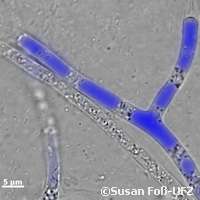Fungi play role in the fight against toxins

Fungi play an important role in the ecosystem, but scientists are still finding out just how big a role they really play in nature. Some fungi are easily recognisable, like mushrooms, most of which stick up out of the ground. Other fungi, however, exist beneath the Earth's surface where they extend, creating fungal threads through the soil. These fungal threads operate in a manner similar to road networks allowing bacteria to travel across them. Scientists from the Helmholtz Centre for Environmental Research (UFZ) in Germany are only now discovering another important traveller on these fungal highways: contaminants that would have otherwise remained immobile in the ground. These networks contribute to the restoration of impacted areas. Published in the journal Environmental Science & Technology, this study was funded in part by the BIOGRID ('Biotechnology information and knowledge grid') project, which received almost EUR 835 000 under the Information Society Technologies (IST) Thematic area of the EU's Fifth Framework Programme (FP5).
Most fungi exist in the environment in a symbiotic relationship, sometimes beneficial, other times antagonistic, or just existing causing neither harm nor benefit. According to the scientists, these fungal threads can form a relationship with and help contaminant eating bacteria. Certain bacteria exist that can nourish themselves on toxic chemicals and at the same time convert these into harmless substances, thus restoring impacted ground by natural means. But the bacteria may not always be around to feed. 'The problem is that the contaminants often do not even reach them,' explained UFZ researcher Lukas Y. Wick, who led the study.
The bacteria have difficulties with substances which are insoluble in water. These include, for example, the polycyclic aromatic hydrocarbons (PAHs) found in crude oil and coal, released in practically all combustion processes. In the complicated labyrinth of water-filled and air-filled pores found throughout the soil, however, bacteria and PAHs rarely come together. This is because the microorganisms are predominantly found in water and in thin liquid films.
'The PAHs are virtually insoluble in water, so that they frequently staple themselves to particles of ground in tiny, air-filled pores,' which the bacteria are unable to reach, said Dr Wick. Air barriers exist between them and their sources of nutrition.
In a previous study, Dr Wick and colleagues discovered that bacteria were able to use the infrastructure of these fungal networks. The fungal braiding operated as a kind of highway over which microorganisms can travel and propagate. They move on the surface of the hyphae and overcome air barriers between two water-filled pores without any problem. In their new research, together with colleagues from the University of Lancaster in the United Kingdom, the UFZ team explored the possibility that contaminants could also travel across the same fungal braiding.
For their study, the researchers used a pseudo-fungus called Pythium ultimum, which is widespread in the soil. This was placed on a central plate with nutrients, proceeding from which it could extend its hyphae to the right and left to two further sources of nourishment. The three nourishment stations were connected by rectangles of nourishment-free material. However, there were several gaps between the nourishment plates and rectangles containing only air. These were intended to simulate the air-filled pores in the ground.
At the edge of a rectangle the UFZ researchers applied a polycyclic aromatic carbohydrate called Phenanthrene. They then investigated at regular intervals whether this substance could be detected in other areas of the test path. 'The results were astounding,' said Dr Wick. Within a few hours the carbohydrate had migrated from one end of the experimental arrangement to the other, from 10 to 100 times faster than it could have by simple diffusion. It was also able to overcome the air gaps with no difficulty, something that was not possible over the same path without hyphal networks.
'The hyphal networks are therefore not only highways for bacteria, but also pipelines for contaminants,' said Dr Wick. 'Per hour a single hypha can transport up to 600 times the weight of an individual bacterium.'
The British team observed this transport in detail. The contaminant migrates through the cell wall into the interior of the hyphae. There, it is enclosed in tiny bubbles, which Pythium ultimum then actively pumps through its far-reaching network. In this way the fungal pipeline mobilises not only Phenanthrene but also other substances virtually insoluble in water and therefore sooner immobile substances.
The researchers repeated the experiment with a number of different PAHs, and all were found to be efficiently transported. However, over longer paths the transport of small molecules functioned better than that of large molecules. 'Presumably the latter are not taken up as well by the hyphae,' commented Dr Wick.
The researchers hope that this effect can be utilised in future for the restoration of impacted ground. The targeted use of fungal networks could accelerate the degradation of PAHs and perhaps also of other substances virtually insoluble in water. 'But this may function only when one combines the right fungi and bacteria,' explained Dr Wick. Some types of these organisms are simply not compatible or even mutually inhibit each other. The UFZ researchers are now searching for the most suitable partners for their microbial contaminant eliminator team.
More information: Furuno, S., et al. 'Mycelia Promote Active Transport and Spatial Dispersion of Polycyclic Aromatic Hydrocarbons'. Environ. Sci. Technol. 2012, 46, 5463-5470
Journal information: Environmental Science & Technology
Provided by CORDIS


















